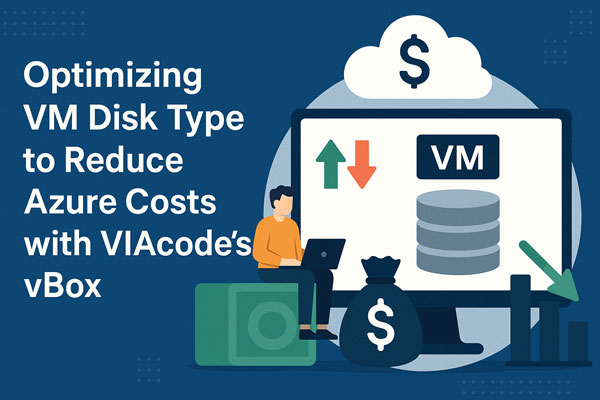VIAcode’s Azure Managed Services target the Azure infrastructure problems we see most often. Businesses migrate to Azure with clear goals, but they find it challenging to maximize the platform’s potential. We aim to help our clients to solve their Azure infrastructure problems and fully exploit the cost, security, and process advantages of hosting cloud infrastructure on Azure.
Azure is a sophisticated platform with dozens of services and minimal support. Cloud newcomers lack the experience or the expertise to optimize their Azure infrastructure. They pay more than they should. They waste time troubleshooting issues that more experienced users know to avoid. They misconfigure cloud resources, causing security vulnerabilities—80 percent of security breaches are due to misconfigurations.
Our first priority is to help businesses to overcome the 4 most significant challenges of hosting applications on Azure.
Problem 1: Overspending On Cloud Resources
Overspending is Azure users’ biggest concern. They migrate to Azure expecting to reduce infrastructure spending. But their Azure bill grows over time as they fail to capitalize on cloud advantages such as on-demand pricing and elasticity.
It’s estimated that over $14 billion are wasted in the cloud each year. The principal causes of cloud waste are:
- Idle resources.
- Over-provisioned resources.
- Azure’s complex pricing model.
- Orphaned resources.
We have been able to reduce client cloud spending by up to 40 percent by focusing on cost optimization in these areas. The most effective cost optimization strategies include migrating to reserved VM instances, deallocating idle resources, and implementing autoscaling while downsizing over-provisioned infrastructure.
Problem 2: Increased Security Risk
Azure is a secure cloud platform, but Microsoft shares responsibility for security with its users. Security responsibilities vary across Azure services, and users often struggle to understand precisely what aspects of security they are responsible for.
Azure gives users the tools they need to secure their infrastructure, but it is up to users to use those tools effectively. We help our clients to implement a layered security policy that extends penetration time and reduces risk throughout the infrastructure and software stack.
Our Azure Managed Services begin with implementing Security Center, which provides proactive security recommendations and enhanced monitoring and alerting. Then, we focus on high-impact security optimizations, starting with free optimizations with no user impact.
Security quick wins include:
- Encryption at rest for VM volumes.
- End-point protection, which installs anti-malware software on VMs.
- Encryption in transit, with testing and monitoring to minimize disruption.
- Secure management ports.
- DDoS protection
- Multi-factor authentication.
Problem 3: Lack of Monitoring and Alerts
Azure generates extensive telemetry and includes a sophisticated monitoring platform with Azure Monitor, but it provides no out-of-box alerts and notifications. The lack of out-of-the-box alerts is in stark contrast to System Center Operations Manager (SCOM) and its Management Packs, which many Azure users are familiar with from their on-prem infrastructure.
The lack of alerts and notifications leaves businesses in the dark about the status of their infrastructure, impacting cost optimization, security, availability, and performance.
Our managed services will increase your business’s Azure monitoring coverage and create actionable alerts focused on the information you care most about, including, among others:
- Azure platform availability with Azure Resource Health.
- Capacity monitoring with alerts for VMs, SQL, Storage, and more.
- Service performance with Application Performance Index (APDEX) alerts on Application Insights resources.
- End-point availability
- Cost monitoring with budgets and alerts.
Problem 4: Inefficient Development and Incident Response Processes
Implementing insightful alerts and notifications is the first step in building efficient DevOps processes, but alerts have to go somewhere, and someone has to be responsible for acting on them. Lack of insight and joined-up processes hurts the business’s incident response times, agility, and operational efficiency.
We work with clients to implement a three-stage process optimization strategy that focuses on improving visibility, establishing accountability, and facilitating collaboration.
- Improve Visibility: We work with your team to connect SCOM to Azure Monitor and expand monitoring coverage for applications and infrastructure.
- Establish Accountability: We funnel recommendations from our Cloud Maturity Assessment and Azure Monitor alerts into the VIAcode Incident Management Systems (VIMS), a powerful ticketing and incident management tool.
- Facilitate Collaboration: To close the loop, VIMs integrates with Azure DevOps for implementation, Azure Automation for auto-remediation, and collaboration platforms such as Microsoft Teams.
We have outlined one process optimization pathway here, but our Managed Services team will work with you to implement the optimizations that suit your business’s requirements and tooling.
Are you ready to solve your Azure infrastructure problems? Contact an Azure managed services specialist today for a free initial consultation or take our free Azure infrastructure optimization assessment.


